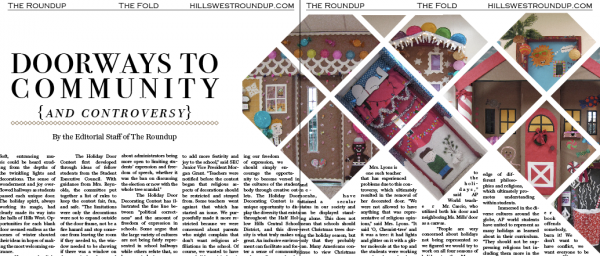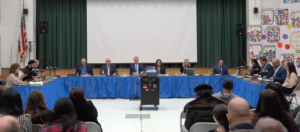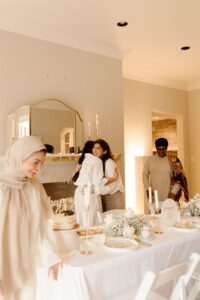Doorways to Community and Controversy

Soft, entrancing music could be heard exuding from the depths of the twinkling lights and decorations. The sense of wonderment and joy overflowed hallways as students passed each unique door. The holiday spirit, always working its magic, had clearly made its way into the halls of Hills West. Opportunities for each blank door seemed endless as the scenes of winter shouted their ideas in hopes of making the most welcoming entrance.
However, the light and festive mood of the holiday door decorating contest quickly turned sour as sentiments of disunity and controversy began circulating around the school after rumors that the contest would not allow any trees or forms of certain symbols essential to the celebration of the holiday season. “The things that are banned are references to non-secular holidays, so like I have a giving tree in the front of the school and that’s a tree,” continued Mrs. Reynolds. “That’s allowed. You know, but it is all about how each individual views the decoration. It is kind of a grey territory … [the contest] was really just something to bring students and faculty together.”
The Holiday Door Contest first developed through ideas of fellow students from the Student Executive Council. With guidance from Mrs. Reynolds, the committee put together a list of rules to keep the contest fair, fun, and safe. “The limitations were only the decorations were not to expand outside of the door frame, not be a fire hazard and stop someone from leaving the room if they needed to, the window needed to be showing if there was a window on that particular door, and no references to religious or secular holidays,” said Mrs. Reynolds. “I was running the contest with the hopes that everyone would abide by the rules … It really was just to do something fun, to bring something different to the school and to get teachers and students excited.”
Still, others have expressed that the effects of the contest resulted in discord rather than the unity it was intended to bring. One such student that has vocally expressed his opinion on the debacle is Junior Gilbert Spencer. “There is a petition being signed for Dr. Catapano to lift the ban on trees,” Spencer continued. “Hopefully, it might work, but the issue is more about administrators being more open to limiting students’ expression and freedom of speech, whether it was the ban on discussing the election or now with the whole tree scandal.”
The Holiday Door Decorating Contest has illustrated the fine line between “political correctness” and the amount of freedom of expression in schools. Some argue that the large variety of cultures are not being fairly represented in school hallways while others refute that, so long as students come up with the door design, students should be able to decorate however they want. According to the American Civil Liberties Union, “Students may express their religious beliefs in the form of reports, homework and artwork, and such expressions are constitutionally protected. Teachers may not require students to modify, include or excise religious views in their assignments.” In other words, teachers may not be permitted to assign the crafting of a paper mache christmas tree as an assignment, but students are allowed to create such depictions (deemed as artwork) so long as they come up with the idea.
“The SEC started this holiday door contest to add more festivity and joy to the school,” said SEC Junior Vice President Morgan Grant. “Teachers were notified before the contest began that religious aspects of decorations should be restricted and strayed from. Some teachers went against that which has started an issue. We purposefully made it more restricted because we were concerned about parents who might complain that don’t want religious affiliations in the school. Of course, we wanted to have more holiday spirit, but it is because of the issue of complaints and the offense it could bring.”
The prohibition of religious symbols in the contest undoubtedly sparked a debate within the school over whether students can or cannot display their own views of the holiday season in school. Every student should be included in the door decorating contest so that the school reflects the diverse group of students at Hills West. While the contest was clear in stating its rules in which no religious symbols were permitted, Christmas trees, menorahs and the like are more closely associated with the holiday spirit rather than strict religious practices.
Instead of limiting our freedom of expression, we should simply encourage the opportunity to become versed in the cultures of the student body through creative outlets. The Holiday Door Decorating Contest is a unique opportunity to display the diversity that exists throughout the Half Hollow Hills Central School District, and this diversity is what truly makes us great. An inclusive environment can facilitate and foster a sense of community, understanding, and education of the diverse backgrounds and cultures of our student body. Imagery shouldn’t offend — instead, it should spark an opportunity to bridge the gap between cultures and promote understanding. Our individualities should be openly expressed without restrictions. This is the way we promote unity within our community: through education.
According to the Religious Freedom Center, “The high court has ruled … that the government may not erect an explicitly religious symbol (such as a creche or menorah) unless it is part of a larger “secular” holiday display … Interestingly, a majority of the justices has stated that Christmas trees, unlike creches and menorahs, have attained a secular status in our society and can be displayed standing alone. This does not mean that schools should erect Christmas trees during the holiday season, but only that they probably can. Many Americans continue to view Christmas trees as religious symbols, and for this reason schools may wish to be more sensitive than the law requires. The Court also has acknowledged approvingly that Christmas carols are frequently sung in public schools.”
Even students who do not subscribe to the Christian religion still decorate trees at home in the spirit of the season. One such students is freshman Cole Silber. “We call it a Hannamas tree,” said Silber. When asked about the controversy over trees being used in a holiday context, he was unmoved. “It gets the class involved in something. It doesn’t matter, it’s just about the entire holiday season.”
Chemistry teacher Mrs. Lyons is one such teacher that has experienced problems due to this controversy, which ultimately resulted in the removal of her decorated door. “We were not allowed to have anything that was representative of religious opinions,” said Mrs. Lyons. “It said ‘O, Chemist-tree’ and it was a tree: it had lights and glitter on it with a glitter molecule at the top and the students were working to make other molecules to attach to the tree. It wasn’t intended to be a Christmas tree, but it was taken that way by some people. I took it down last Friday. I’ve kinda given up on doing the door decorating project because it was just a lot of work and I don’t want to start over.”
This dilemma has turned some teachers away from participating in what was supposed to be a fun activity. But for some, it has only spurred their motivations to go above and beyond in creating a diversified door. “My true design is supposed to be an eclectic view of all the holidays, little known facts, and little known holidays for all four seasons, this way we can have a dynamic approach to the holidays,” said AP World teacher Mr. Cascio, who utilized both his door and neighboring Ms. Mills’ door as a canvas.
“People are very concerned about holidays not being represented so we figured we would try to work on all four seasons of holidays together. My seventh period AP class brainstormed with me for the design. I like the contest, and I think that the people that are offended should relax. I do anticipate negative feedback because you can’t please everybody in this world.”
The Advanced Placement World History curriculum, for the past few years in which it has been in place, has certainly taken strides against promoting euro-centric learning. Instead, the curriculum (which replaced the European History curriculum back in the Fall of 2013) focuses on the extensive history of cultures outside of the Western sphere. AP World History has certainly opened up doors to knowledge of different philosophies and religions, which ultimately promotes understanding within students.
Immersed in the diverse cultures around the globe, AP world students have united to represent as many holidays as learned about in their curriculum. “They should not be suppressing religions but including them more in the school setting to spread knowledge of other cultures,” said AP World student Steven Secreti. “We should use this holiday time to inform students of religions we have incorporated into our lives.”
“It reminds me of the Starbucks debacle last year about, you know, you weren’t allowed to allude to trees,” said English teacher Mrs. Benson. “[The holiday door decorating contest] is very similar to the Starbucks cups. We’re reading Fahrenheit 451 [in the freshman English classes], and — remember when Captain Beatty explains to Montag that one of the reasons the public stops reading on their own is for censorship! If a book offends somebody, burn it! If another book offends somebody, burn it! We don’t want to have conflict, we want everyone to be at peace. We want everyone to be happy…I think we should all find out about each other’s heritage and religions because then we will see similarities that it’s the same God. As Calpurnia says to Lula in To Kill A Mockingbird, “it’s the same God, ain’t it?” said Mrs. Benson.
The Roundup staff agrees: Instead of limiting conversation, let’s talk about our differences. Let’s continue to build our community. Let’s not ignore the cultural harmonies that make Hills West great.







